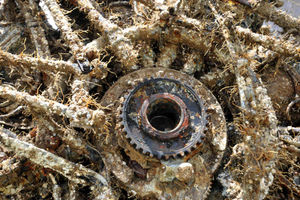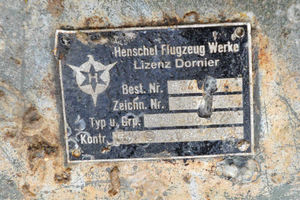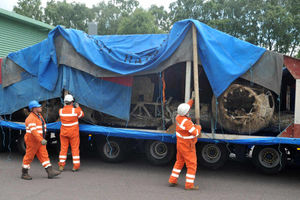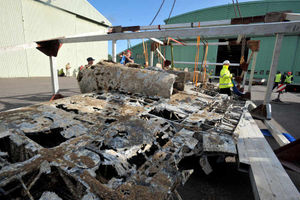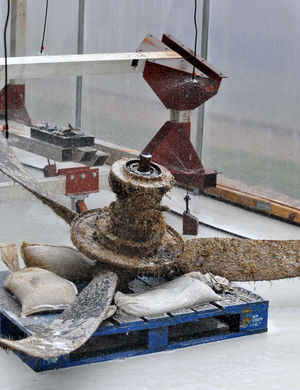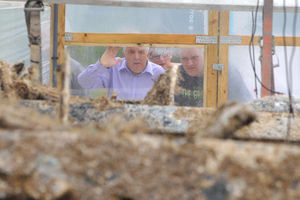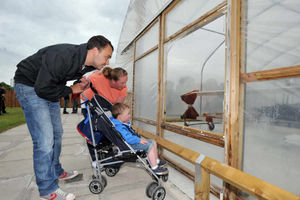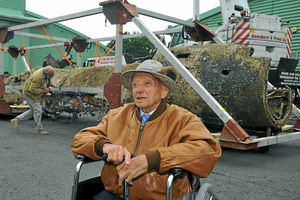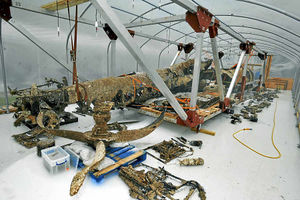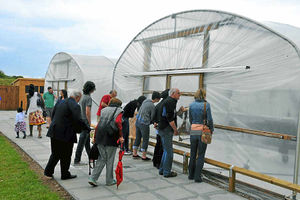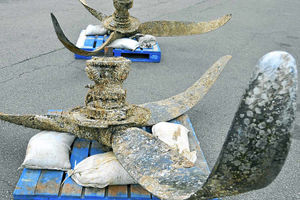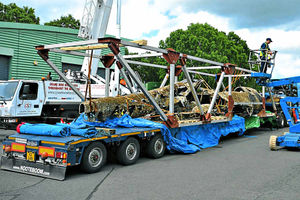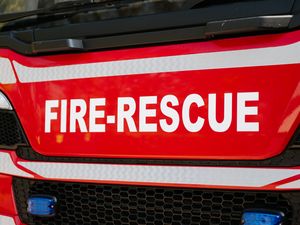Dornier bomber already a big hit at RAF Cosford
After weeks of frustration and delays caused by the weather, the last surviving Dornier 17 bomber has finally arrived at RAF Cosford where work was today starting to return it to its former glory.
The German aircraft, which was brought in by lorries after being lifted from the English Channel off the Kent coast, was greeted by cheering crowds at the Shropshire museum.
RAF Cosford's new arrival is now available for public viewing and people gathered around the white polytunnels that have been put up to house the bomber.
It had travelled from Ramsgate after being pulled out of the sea in a £500,000 recovery operation and a six-week mission involving 50 specialists.
Covers were firstly taken off the fuselage, the main body of the plane, before it was unloaded by crane.
The wings, engine and other parts of the aircraft were then unloaded over the weekend and placed in purpose-built hydration tunnels, together with the fuselage, for them to be sprayed with citric acid and water to remove crustaceans and barnacles from the metal.
They will continue to be monitored and it could take between 18 months and two years before the next stage of the conservation work starts.
The plane will eventually be transferred to the RAF Museum at Hendon in London.
Crabs have been found in the engine of the salvaged bomber, shot down by the RAF in 1940, and traces of oil were found in the oil cooler. The propellers show the damage inflicted during the bomber's fateful final landing, but incredibly the tyres remained inflated.
Experts from the RAF Museum and marine recovery company SeaTech successfully lifted the plane from its watery grave at Goodwin Sands, last Monday.
The rescue attempt continued to be scuppered by bad weather and other setbacks, but Darren Priday, deputy conservation centre manager at RAF Museum Cosford, was at the scene to see it finally emerge.
He said: "It's been a long and tiring week with highs and lows.
"It was a huge relief to see her for the first time. It was just pure excitement."
Andy McGlynn, head of fundraising at the RAF Museum at Cosford, had also watched the plane emerge from the water while on a boat just over 300 feet away.
He said: "There was quite a slow movement where they had to swing it round under the water to get it on the barge. It was amazing when it came out of the water.
"It was surreal. It looked like a prehistoric sea creature rising from the depths."
Standing by the sidelines to watch the action was John Hawker, of Crackley Bank Farm, Shifnal, who said it was an "emotional" experience.
The 70-year-old father-of-two said: "I've been excited about it coming here. It brings back the old memories of growing up. The war ruined our childhood. It was very hard growing up afterwards. It's very emotional for me."
Museum visitor Richard Myers, 45, from Bridgnorth said: " I have always been fascinated by military aircraft and this was the missing piece in a jigsaw. I have bought my son, Elliot, seven, to see it because this is history coming alive before us. I am very pleased to have the opportunity to see it."
Thomas Shortland, 57, from Newport, said: "It is a great opportunity to see a piece of history being restored."
Yesterday, more people travelled to the site to catch a first glimpse of the aircraft.
Aviation fan Ben Gilbert, who works as a duty officer at Newport Swimming Pool, came to see the Dornier with his wife Stephanie, who does the same job at Phoenix Leisure Centre, and son Logan, aged two.
Mrs Gilbert, from Broseley, said: "We sometimes come twice a week because we love it at Cosford."
Mr Gilbert added: "I didn't realise they were going to put it on public display quite so soon. I think it's absolutely amazing. I think for it to be the only one of its kind left and for it to be local is pretty special."
Retired landscape engineer Fred Pickering, from Dawley, visited with his daughter Faye Allard, a teaching assistant, her husband Martin and son Robin.
He said: "I think it's absolutely wonderful. For them to be able to get it here is brilliant. The scale of the operation to get it here really shows the commitment to it. There's been a lot of skill involved."
Mrs Allard, who lives in Red Lake, Telford, added: "It is a picture of the past really."
Airman's pilgrimage to see bomber - See today's Shropshire Star
